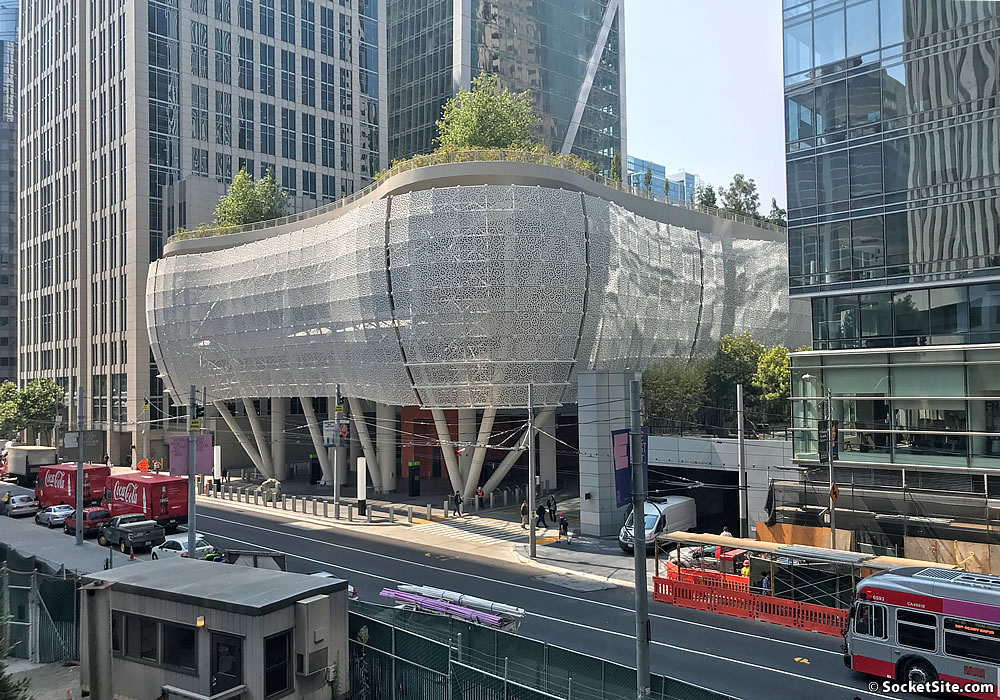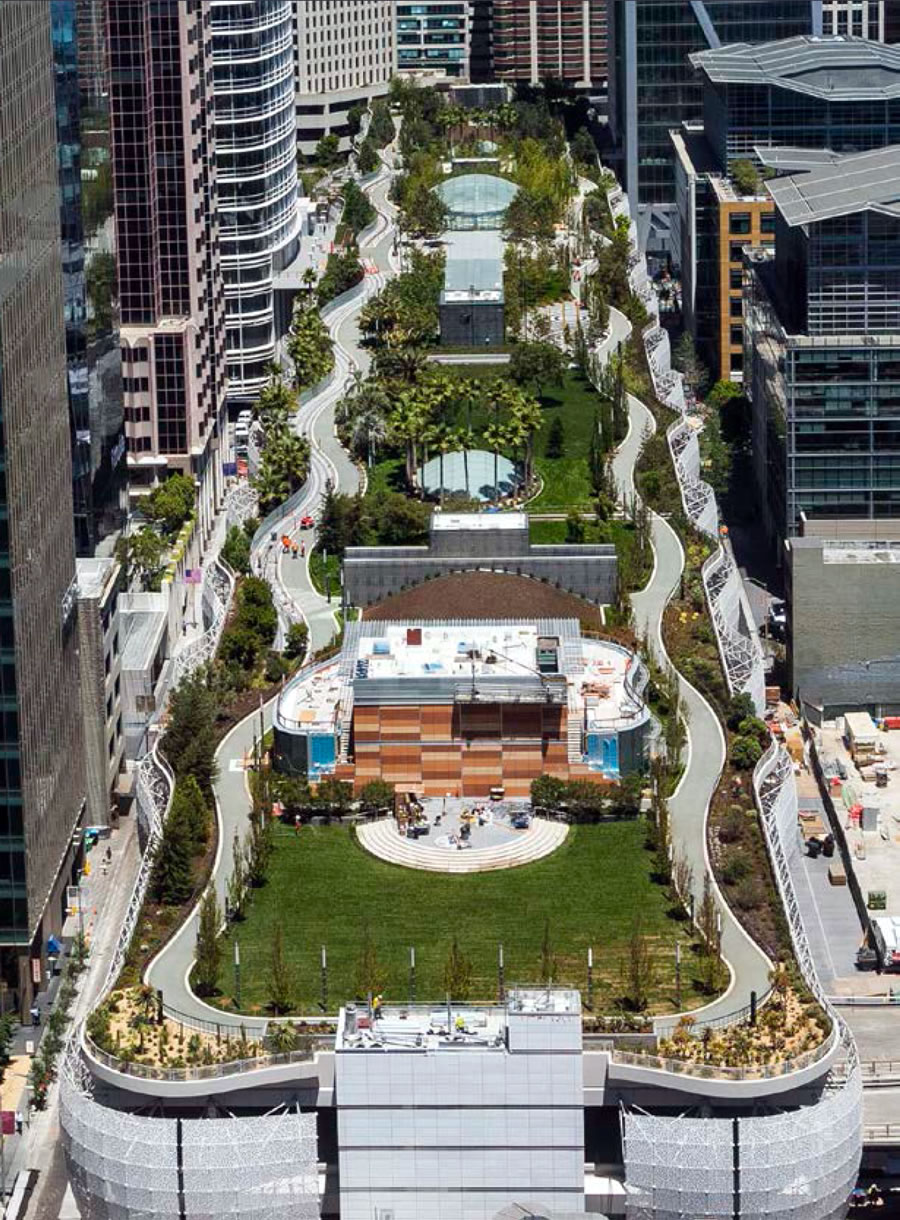With the repair and remediation of the fractured beams that resulted in the emergency closure of San Francisco’s new Salesforce Transit Center having been completed ahead of schedule, and a comprehensive inspection of the entire structure having failed to uncover any new concerns, the transit center and its rooftop park will re-open on July 1, a day later than we were anticipating.
The installation of an all-new concrete pathway atop the transit center’s roof, replacing the original decomposed granite, which was continuing to decompose, will have been completed by the re-opening date as well.
But bus service to the re-opened transit center will be phased over the next couple of months, after which the temporary terminal will be shuttered anew.
UPDATE (7/23): AC Transit service will return to the Salesforce Transit Center on August 11, at which point the service will once again “bypass congested San Francisco surface streets by traveling the dedicated bus ramp” to and from the Bay Bridge.


Maybe they should avoid demolishing the old terminal for a year, just to be safe 🙂
I would think that the people who already bought the land the temporary terminal is on would be unhappy about that, despite it being practical.
worst-case, if the temp terminal were gone and they found another issue, they would likely just take out a ton of street parking in the area “temporarily” for bus stops.
Not like there’s going to be a big event in the city the day before July 1 that could use a functioning transit hub…
The area governments need to step in and fire the transbay board. Their incompetence and poor judgement can not be trusted to carry out the caltrain extension, which should be under construction by now.
How much additional training does one need to drive a bus on a ramp? The drivers had training before the center opened and used it for over a month.
It’s not the Transbay board’s fault that DTX is moving at a snail’s pace. Don’t get me wrong, they’ve been part of the problem. But the blame doesn’t clearly or squarely fall on them; there’s cross-organizational and governmental incompetence to blame there.
How was the conclusion that the transbay board is not at fault arrived at?
“Joint venture Webcor-Obayashi had to file some 12,000 requests for information, a formal inquiry that seeks clarification on construction documents, because the documents furnished were flawed or incomplete, the lawsuit alleges. In some cases, it took the TJPA up to 296 days to respond, according to the suit. As a result, the contractor had to submit more than 1,600 change order requests to correct those errors or omissions, which took an average of 129 days to resolve and “directly impacted the critical path of the project and caused significant delays,” the lawsuit states.”
There is nothing the TJP appears to have done that merits praise.
The Transbay board does not unilaterally control or dictate funding mechanisms and the laundry list of review that the project will go through.
And not (again), that I am not praising the board or absolving them of all blame. Pointing out that these delays require a team effort of incompetence is both factual and uncontroversial.
DTX should have been completed by now. It is a “transit” center, after all, not a bus station. Actually, it’s not even a bus station at this point. Talk about a mega boondoggle.
I don’t think you’ll find anyone who wouldn’t prefer that the project already be done, or under construction at the very least.
DTX will never happen. The true goal has already been reached.
The political will was expended to increase the surrounding height limits, but now the high rises are entitled and nearly all built. Job done.
The DTX? The political will to build something for the people is practically non-existent. Nobody profits from the DTX. Soon enough people will forget the center has train boxes in the basement.
not so sure about that, the surrounding ‘bonus height’ lots paid a premium in part to be adjacent to a regional network hub, and a fancy bus stop doesn’t count. So they are pretty much going to have to build it or potentially face lawsuits from those property owners.
I wish the money that has been spent/wasted on the Central Subway had been spent on DTX.
It’s Transbay board today decided to build bus terminal in phase 1 rather than Caltrain extension in phase 1.
Buses could simply use the temporary location longer.
When does the contra flow Bay Bridge bus lane open… sigh.
don’t hold your breath.
So July 1st is the day SF’s homeless population gets to move in and make a sure mess of things.
It sure will not look like those pictures for long.
Conjecture. The park and transit center, when it was open, did not have issues with this.
It did not, and will not, because there is a fair amount of security presense precisely to keep it under control. The park is closed at night, there is security 24/7 in the building, and the private expensive buildings connected to the park have their own security as well. Maybe at some point in the future it will be allowed to rot (as the old building had, it was actually pretty decent looking in old pictures, but near the end I think it was neglected on purpose to help drum up support for a new terminal)
Americans have proven themselves again and again to be utterly incompetent at anything involving urban infrastructure. Why do we not outsource jobs like this to East Asia or Europe? It is just embarrassing that we can’t get anything right. I just returned from Scandinavia; their transit infrastructure is a dream….ours is not fit for a two-bit banana republic, which is I guess, what we have become.
There are plenty of examples of absurd infrastructure design issues, delays, and cost overruns throughout the developed world. The main thing they do better is building things at a lower cost (or cost per unit).
Look at Berlin’s new airport for example. It was supposed to open in 2011 (under construction since 2006) and won’t open until at least next year, at which point it still won’t have enough capacity to replace the two existing airports. Germany is country known for engineering quality and valuing efficiency, and they still managed to have issues.
For all the whining, the new depot is an improvement on the crumbling urine-stained fetid blight it’s replacing. Looking forward to another beer in the park, maybe with some live music.
It’s seems to me more people take the transbay buses than readers here think.
Just one person’s observation…
My wife works downtown and once she discovered the AC transit ‘O’ bus…well…she hasn’t taken BART in over a year. It’s a pro move if you can find a transbay bus near you. No homeless, AC works, generally on-time (sure when there is shooting or someone dies on the Bay Bridge you can be a little late, but that happens on Bart). She’s never felt unsafe etc etc it’s just professional commuters doing their thing.
I met her for a late lunch and walked over to the bus terminal to catch the O home. The terminal is steady stream of lines to get on the buses. Not like Embarcadero at rush hour. But certainly 1000s of people in lines.
I find that the F line works great for me going into San Francisco (I always get a seat and it stops right in front of my apartment), but I can almost never get a seat going back to Berkeley, so I generally take Bart home.
Links to the primary source about the reopening and (especially) the line about the return of buses being “phased over the next couple of months” would be useful.
Our source was the Transbay Joint Powers Authority (TJPA). And while Muni and Golden Gate Transit will start re-servicing the center “in early July,” AC Transit, Greyhound and Westcat Lynx will return “in late summer.”
UPDATE (7/23): AC Transit service will return to the Salesforce Transit Center on August 11, at which point the service will once again “bypass congested San Francisco surface streets by traveling the dedicated bus ramp” to and from the Bay Bridge.